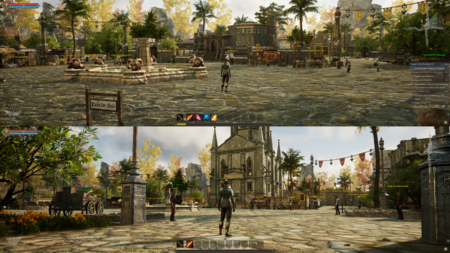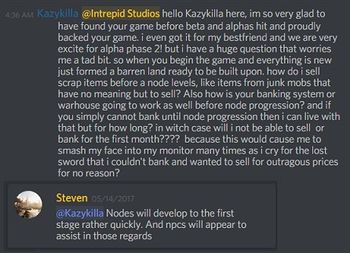מחנה
An encampment is the second stage of node advancement.[1]
פיתוח צומת
פעילות של שחקנים אזרחים ושחקנים לא אזרחים (משימות, איסוף, פשיטות וכו.) בתוך אזור השפעה של צמתים נוספת לפיתוח אותו הצומת (התפתחות). [3][4]
איזור ההתפתחות של הצומת הוא היכן שציביליזציה תופיע כאשר צומת מתפתח. ככל שהצומת עולה שלבים, בניינים שונים, דמויות ללא שחקן (NPCs), ושירותים יהפכו לזמינים באיזור ההתפתחות. ככל שרמת הצומת גבוהה יותר, כך איזור ההתפתחות יהיה מורכב ומאוכלס יותר. אזור ההתפתחות ישתנה גם בהתאם לסוג הצומת - כלכלי, צבאי, מדעי, או שמימי; נרחיב יותר על כל אחד מהסוגים בפוסטים עתידיים בסדרה הזו. [3] – Margaret Krohn
התפתחות של צומת חושפת את התוכן הייחודי שלו, שבאה במחיר של נעילת טבעת הולכת וגדלה של צמתים שכנים מלהתפתח לשלב הבא. [5]
- צמתים מתפתחים לשלב הראשון במהירות. זה מאפשר שירותים של דמויות ללא שחקן כמו מכר או בנקאות של חפצים.[6]
- ככל שצומת מתקדם כך אזור השפעה שלו גדל.[7]
- צמתים פחות מתקדמים (מכונים צמתים צמיתים) שנמצאים בתוך איזור השפעה של צומת מתקדם יותר יכולים עדיין לצבור XP, אבל חייבים להשאר בשלב התפתחות נמוך יותר מהצומת הדומיננטי.[8]
- מערכת הצמיתים מתחילה כאשר צומת מגיע לשלב 3 (כפר), אבל צמתים שכנים החל משלב משלחת (שלב 1) יכולים גם לחסום את הגדילה של השכנים הקרובים שלהם.[9][10]
- אלגוריתם הרחבת הטריטוריה לוקח בחשבון את החוף הקרוב ביותר, צמתים שכנים, ואת מפת החום של שחקנים באזורים הסמוכים במהלך השבועות או החודש האחרון.[11]
- בגלל האופן בו אלגוריתם ההתרחבות מחשב את ההתרחבות הטריטוריאלית (אזור השפעה) במהלך פיתוח צומת, קיימת אפשרות קטנה ששני צמתים באותו שלב יהיו בסופו של דבר קרובים זה לזה.[12]
הדרך שבה האלגוריתם מרחיב שטחים לוקחת בחשבון כמה דברים: דבר ראשון היא לוקחת בחשבון את החוף לדוגמה היכן החוף הכי קרוב. דבר שני היא לוקחת בחשבון את הצמתים הסמוכים כך שהוא יוכל להשתלט עליהם ולהפוך אותם לצמיתים שלו, אבל מה שחשוב יותר זה בעצם האוכלוסייה הראשונית שנקבעת על ידי בחירת השחקנים את הגזעים שלהם. מכיוון שיש לנו תשעה גזעים שונים וארבע נקודות התחלה שונות שמתפצלות, צפיפות האוכלוסייה של כל שרת הולכת להכתיב למעשה את הצמתים הראשונים שיהיו מאוכלסים מאוד ואז הגרעין הראשוני הזה הוא זה שהולך לקבוע את מבנה כל צומת תוך כדי שהוא נע בתוך היבשה בעצם אל תוך העולם; ובהתבסס על הביצועים וההצלחות של מצורים שונים יקבע אילו צמתים שננעלו ממקודם בהתקדמות הראשונית יוכלו להיות זמינים כעת כדי להתקדם הלאה. אז אני באמת חושב שעם כל כך הרבה משתנים שנמצאים במשוואה של איך צמתים מתקדמים ונשארים קיימים ככל שיש לך יותר משתנים, ככה תהיה הסבירות שתהיה התפצלות משמעותית בהתקדמות עולם גבוהה יותר .[11] – Steven Sharif
בדרך כלל האלגוריתם שפועל על הרחבת הטריטוריה של צמתים ימנע מצמתים משמעותיים להיות קרובים זה לזה ... יכולה להיות סערה מושלמת בה כל הרחבה של אלגוריתם הטריטוריה תגרום לכך שצמתים יתקרבו זה לזה מאוד מכיוון שקיימות דרישות מסוימות שצריכות להתקיים בכדי לספק את האפשרות של השתלטות על צמתים צמיתים; וייתכן ששני צמתים לעולם לא יהפכו אחד את השני לצמית ובסופו של דבר יהיו צמודים זה לזה וימשיכו להרחיב את הטריטוריה שלהם בכיוונים מנוגדים: בערך כמו בספר "בין שתי ערים".[12] – Steven Sharif
- צומת לא מקבל XP מהצמתים האחרים שתחת אזור ההשפעה שלו עד שאותם הצמתים מתפתחים לרמה הכי גבוהה שהם יכולים.[8]
- שחקנים יועברו למקום בטוח אם הם נמצאים במקום של נכסים חדשים שצריכים להווצר במהלך התרחבות של צומת.[13]
- אזרחים של צומת אחד יכולים לתרום להתקדמות של צמתים אחרים[14]
ההזדמנויות להשיג ניסיון עבור צומת יהיו שוות עבור כל ארבעת סוגי הצמתים
- האחוז המדויק של התקדמות מהשגת חפצים או מהריגה של מפלצות לא יהיה ידוע במפורש כדי להימנע מ"לשחק" את המערכת.[15]
לאנשים שונים יש משאבים שונים שהושקעו בהתקדמות של צמתים וזה יהיה קצת "משחקי" (gamey) אם היית יכול לדעת בדיוק מה נחוץ באותה נקודה מכיוון שזה יבלום את התמריץ של אנשים להשתתף.[15] – Steven Sharif
Node development

The layout and architecture within a Node’s development area are determined by influential race. For example, a stage 3 Node with the majority of player contribution being Py'rai would have a Py'rai village with Py'rai architecture. Most NPCs would be Py'rai elves, and offer questlines within the Py'rai narrative.[16] – Margaret Krohn
Each player’s contributed experience is flagged with their character race and other identifiers. When a Node advances, the race with the highest experience contribution determines the Node’s style and culture. This style and culture change can happen at every Node Stage. For example, if a Node advances to Level 2 - Encampment Stage and 51% of all experience was earned by Ren’Kai players, the Node will be a Level 2 Ren’Kai Node. If that same Node advances to a Level 3 - Village Stage Node, but the Py'Rai contributed 62% of all the experience earned, then the Node will be a Level 3 Py'Rai Node.[3] – Margaret Krohn
Node layout and style is determined by several factors:[17][18]
- The way that the node system is built is that they can exist across a spread of 18 biomes, but at the same time have to represent the cultural influence of these cultures that are intrinsically a part of a specific biome.[19] – Steven Sharif
- Environment (biome) and location of the node.[19][17][18]
- Nodes will adjust the local topography to fit the aesthetic and mechanical requirements of the node.[20]
- Currently the way that the platform system is set up, is it's capable of adjusting the topography of the node's footprint, regardless of the surrounding terrain. So the reason for that is we want to have flexibility in the presentation of the node's layout and how it is essentially both from an aesthetic standpoint as well as a mechanical standpoint with node sieges- how it's constructed and that construction should have the ability to take on a variance of different types of topography. So it shouldn't be dependent on the surrounding area. Now that's not to say that the surrounding area isn't going to have some influence over. So for example... we're experimenting a little bit with the platform tech and putting up a node up against the side of a mountain or on the edge of a cliff or something that has a beautiful vista. Those are things that we're going to test out obviously as we continue to work on the node tool and how that platform system works, but the idea is to have the node independent of the surrounding terrain.[20] – Steven Sharif
- Some parts are determined by the area it's in. Some parts are determined by the type it is. Some parts are determined by the race it is; and then the rest of it is determined by the mayor.[18] – Jeffrey Bard
- Race that contributed the highest percentage to the node's advancement will alter the racial appearance of its buildings, דמויות ללא שחקן, and props.[21][22][17][3][18][23][24]
- All nodes, whether they're associated with a castle or associated with normal node structure, has cultural influences that replicate over to the buildings that are produced and the NPCs that are present.[26] – Steven Sharif
- The rest is determined by the node's mayor.[18]
- It should be possible for a node to complete several building projects within a mayor's one month term in office.[27]
- Q: How long would you say it will take players on average to fill/build up a node completely from wilderness to metropolis?
- A: It's one thing to get a node to a certain level: it's another thing to develop the node; and I can't really give you an on-average expectation, because there's a lot of variables at play. There's how many citizens does the node have attracted to it; what's the type of traffic that the node is attracting to it based on things like its tax rates, or the specialization that it chose to spec into, based on the building types it's chosen to build. All of those things are variables that can affect the quote-unquote "average build-out time" of a particular node. So it's difficult to give you an average when there's so many variables along those lines. But the idea is that if there is a particular project that players are interested in in developing based on the node stage, that they would have the ability to complete several of those projects as within a single term of a mayor; and a term of a mayor is one month.[27] – Steven Sharif
Artwork
See also
הפניות
- ↑ 1.0 1.1 Node series part II – the Metropolis.
- ↑ שידור חי, 2017-09-03 (43:34).
- ↑ 3.0 3.1 3.2 3.3 3.4 Blog - Know Your Nodes - Advance and Destroy.
- ↑ A reactive world - Nodes.
- ↑ וִידֵאוֹ, 2017-04-20 (0:02).
- ↑

- ↑ Node series part II – the Metropolis.
- ↑ 8.0 8.1 שידור חי, 2017-10-16 (50:20).
- ↑

- ↑

- ↑ 11.0 11.1 רֵאָיוֹן, 2020-07-18 (10:04).
- ↑ 12.0 12.1 רֵאָיוֹן, 2020-07-08 (1:00:15).
- ↑ שידור חי, 2017-11-17 (55:27).
- ↑

- ↑ 15.0 15.1 שידור חי, 2017-05-26 (28:16).
- ↑ Blog - Know Your Nodes - The Basics.
- ↑ 17.0 17.1 17.2 שידור חי, 2020-10-30 (39:17).
- ↑ 18.0 18.1 18.2 18.3 18.4 18.5 שידור חי, 2018-09-27 (53:06).
- ↑ 19.0 19.1 שידור חי, 2022-02-25 (41:00).
- ↑ 20.0 20.1 שידור חי, 2021-02-26 (1:12:18).
- ↑ שידור חי, 2022-03-31 (4:57).
- ↑ פודקאסט, 2021-04-11 (29:47).
- ↑ רֵאָיוֹן, 2018-05-11 (54:34).
- ↑ שידור חי, 2017-05-26 (21:23).
- ↑ פודקאסט, 2021-04-11 (23:36).
- ↑ 26.0 26.1 רֵאָיוֹן, 2018-05-11 (47:27).
- ↑ 27.0 27.1 שידור חי, 2022-07-29 (1:13:09).




















